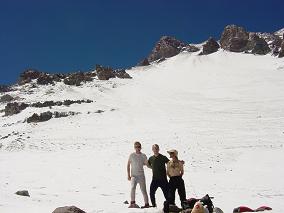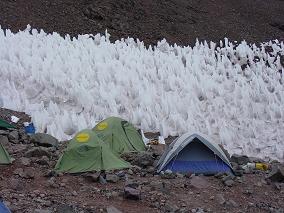
|
Meteorology |

|
bove Base Camp Aconcagua is a cold and often windy mountain. These are the chief weather-related issues of any climbing route on the "Stone Sentinel". Improperly clothed, one can easily receive cold injuries on summit day - including frostbite.
Aconcagua lies near the 33rd parallel - as does San Diego in southern California. Weather patterns and climate are symmetrically related about the equator. Aconcagua thus enjoys the same generally dry climate during the summer months as the Sierra Nevada of California some 300 miles north of San Diego (a small distance on the global scale). When storms do occur they are short in duration - at most two days. This contrasts with Mount McKinley, where storms last for several days without break.
Weather at Aconcagua arrives from the nearby Pacific Ocean. High altitude winds batter the higher elevations unabated by local terrain. There results a diurnal temperature variation that is remarkably small because there is little or no landmass to moderate the airflow. Summit temperatures thus differ very little between day and night. Lower down, such as at Plaza de Mulas Base Camp, daily temperature swings are large - the standard observation for what is basically a desert environment.
Here are some typical observations from our ascent.
APPROACH HIKE. It can be hot on the two-day approach to Base Camp. Bring a tee-shirt and a sunhat. The tee-shirt can be left at Base Camp. Leather hiking boots are recommended for the approach - to be swapped in favor of double plastic boots above Base Camp.
BASE CAMP. Overnight low 25° F; afternoon high 50° F. Water freezes overnight, so bring all containers into your tent for the night. It can get downright "toasty" in your tent - remove all clothing layers save one.
The direct sun does not appear until roughly 9:30 a.m. (in mid-January). Before then expect uncomfortable cold. I wear two layers on both top and bottom while outdoors - and a parka when the sun is hidden.

|
|
A warm afternoon (40° F) at the Lower Condores camp. From viewer's left: Edward, John, Adam (shirtless). Aconcagua's summit is the triangular rock pinnacle immediately above John and Adam. |
LOWER CONDORES. Overnight low 15° F; afternoon high 30° F. One day has an estimated 40° F (and the FM radio cites a record high that day in Santiago as 35° C = 95° F). On this day we sunbath outdoors under a brilliant sun. I wear three layers on both top and bottom - including windpants.
CAMP BERLIN. Overnight low 5° F; afternoon high 15° F. This camp can be very windy. On such a day you may wish to cancel summit plans for a calmer period - the wind chill factor is well below zero Fahrenheit.
It can be remarkably balmy inside your tent mid-day, the very high altitude sun being exceptionally strong in its warming capacity. However at night it will be below freezing inside the tent - so take water bottles to bed by keeping them inside your sleeping bag overnight. A frozen water bottle is good for nothing on summit day. Urine bottles can be treated similarly.
Camp Berlin does not have "Mount McKinley temperatures" - but the conditions do call for multiple layers and care when selecting handwear on summit day before sunrise. I wear five top layers and four bottom layers on summit day. A sixth top layer, my turquoise parka, is worn while stationary prior to the ascent, and at the summit.
Plastic double mountaineering boots are essential. Then again, Zurbriggen in 1897 had no such modern equipment during this first ascent by a westerner.6,7
Before sunrise the effects of cold are accentuated. I wear three hand layers - inner gloves; Outdoor Research mittens; and the matching wind shells. Wearing the mittens, I lack the dexterity to place on the shells. Edward assists by holding the shells in-place as I push the mittens into them. Who will perform this favor for me on Mount McKinley some day?
Above Base Camp I generally do not remove my liner gloves. I consider them a "second skin", growing used to the gloves until I consider it "normal" to wear them rather than have bared flesh. I wear the liner gloves even inside the tent, except when it is mid-day and exceptionally warm therein. The mittens are used only when outdoors since they preclude any activity requiring fine handwork.
I have gloves, indeed two pairs, and yet never use them because any temperatures cold enough to require more than liner gloves could more readily (and completely) be mitigated with warmer mittens.
We cook in the tent vestibule, and eat inside it while above Base Camp. This is important as I would not have been able to properly eat, let alone enjoy my meals outside when forced to wear mittens: I constantly add spices located in ziplock bags; salt the food (often with potassium chloride to avoid a deficiency encountered the previous summer); and otherwise perform operations requiring fine hand movements.
Furthermore, food cools too quickly if eaten outdoors. As noted, owing to their shape, breakfast pancakes are a special problem in this regard. I learn from Edward Earl that on guided Mount McKinley expeditions it is normal to eat meals outdoors - and quickly lest the food freeze. THAT CONCEPT IS SO DESPICABLE IN MY VIEW that it provides a major motivation for organizing a private ascent of that great mountain. By that means there is some measure of control over where and how meals are prepared and consumed. Stated differently, I will not pay $5,000 only to eat cold food for three weeks.
Butane lighters (purchased in Mendoza) prove unreliable in the cold. We soon find that the fluid itself is not needed to start our stoves - only the spark created by "flicking your Bick". Seeing this growing problem at Lower Condores, I secure a box of strike-anywhere matches from an Austrian climbing party as they camp for the night.
SUMMIT. Both the daily low and high tend to center around 0° F. Note how the daily temperature variation declines with each successively higher venue. With a substantial wind the sensation of cold is markedly enhanced. I cannot suggest an upper limit to how windy it must be before a summit attempt is postponed - it depends on your level of commitment; willingness to sacrifice fingers; and any innate suicidal tendencies.
We are fortunate to enjoy a relatively calm summit day. The wind is bothersome at the Independencia hut (21,000 feet) - but quickly dies down to a tolerable level.
6Zurbriggen's first ascent mistakenly put him atop the slightly lower, west summit.
He descended to the saddle and climbed to the true, east summit.
7Inca peoples might have climbed Aconcagua.

|
|
Nieve penitentes ("praying icicles") near Plaza de Mulas base camp. |
| previous page - Mental, Emotional, and Personal Issues | next page - GPS-Derived Coordinates and Elevations |